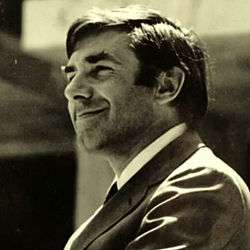Donald Appleyard
| Donald Appleyard | |
|---|---|
|
Donald Appleyard | |
| Born |
Donald Sidney Appleyard July 26, 1928 London, England |
| Died |
September 23, 1982 Athens Greece |
| Cause of death | Traffic Collision |
| Education | graduated MIT; |
| Occupation | academic, author, City Planning Urban theorist |
| Employer | MIT, UC Berkeley |
| Notable work | Livable Streets |
| Home town | Berkeley, California |
| Spouse(s) | Sheila Appleyard |
| Children | Rustin Appleyard, Moana Appleyard, Bruce Appleyard, Ian Appleyard |
Donald Appleyard (July 26, 1928 – September 23, 1982) was an urban designer and theorist, teaching at the University of California, Berkeley.[1]
Born in England, Appleyard studied first architecture, and later urban planning at the Massachusetts Institute of Technology. After graduation he taught at MIT for six years, and later at the University of California, Berkeley. He worked on neighbourhood design in Berkeley and Athens and city wide planning in San Francisco and Ciudad Guayana. He died in Athens as a consequence of a traffic collision.[2]
His 1981 book Livable Streets was described at the time by Grady Clay, the editor of the Landscape Architecture magazine, as "the most thorough and detailed work on urban streets to date".[1] It contained a comparison of three streets of similar morphology in San Francisco, which had different levels of car traffic: one with 2,000 vehicles per day, the others with 8,000 respectively 16,000 vehicles per day. His empirical research demonstrated that residents of the street with low car traffic volume had three times more friends than those living on the street with high car traffic.[1]
Appleyard is co-author with Allan Jacobs of the paper "Toward an Urban Design Manifesto".
In 2009, he was named one of Planetizen's Top 100 Thinkers of all time. He was ranked 57.
Publications
- The View from the Road, Cambridge, MA: MIT Press, 1964.
- Planning a Pluralistic City, Cambridge, MA: MIT Press, 1967.
- The Conservation of European Cities, Cambridge, MA: MIT Press, 1979.
- Livable Streets, University of California Press, Berkeley, 1981
- Toward an Urban Design Manifesto, Allan Jacobs and Donald Appleyard. Working Paper published 1982; republished with a prologue in the Journal of the American Planning Association, 1987.[3]
References
- 1 2 3 Project for Public Spaces: Donald Appleyard, retrieved 29 September 2011
- ↑ Allan B. Jacobs, C.C. Cooper-Marcus and T.G. Dickert: "In Memoriam: Donald Appleyard, City and Regional Planning; Landscape Architecture: Berkeley", retrieved 29 September 2011
- ↑ Allan Jacobs and Donald Appleyard, Toward an Urban Design Manifesto, APA Journal, Winter 1987
Further reading
- The Writings of Donald Appleyard, in Places, Vol I, Nr.3
External links
- Diagram of social interaction relative to car traffic from Livable streets, 1981
- Exposure of Appleyards findings
- Finding Aid to the Donald Appleyard Papers, 1954-1982, bulk 1966-1982, The Bancroft Library
